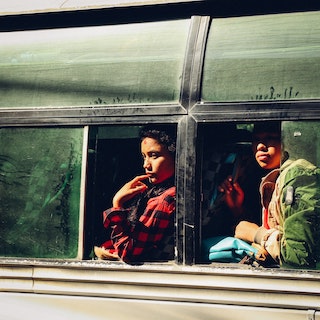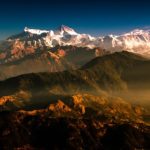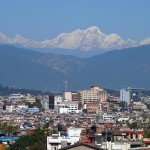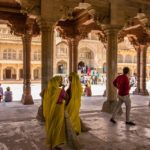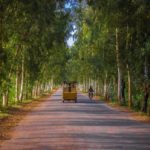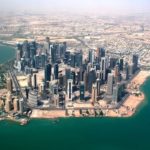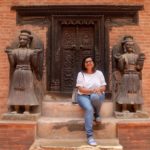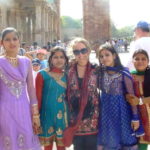Surviving the 30+ Hour Bus from Kathmandu to Delhi
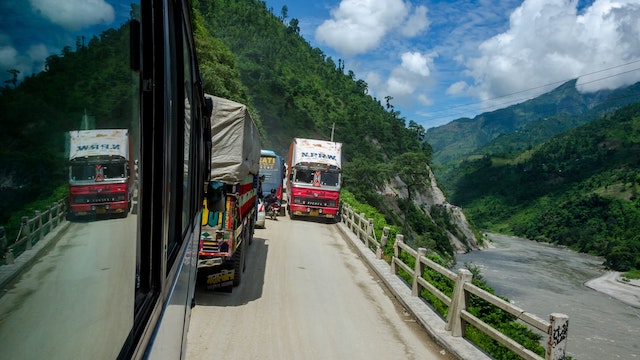
I would like to be one of those travel writers who chooses the most uncomfortable, most intrepid means of getting anywhere, simply because it makes a better story. But I’m not. I’d much rather have flown from Kathmandu to Delhi, a journey of 800 kilometres, than take the Kathmandu to Delhi bus, which takes 30+ hours. However, due to circumstances beyond my control, I had to leave the trip planning till the last minute, and the flights were unaffordable. So the bus it had to be. And at just Rs 3800 (US$38), it isn’t a bad deal.
I came across a blog post describing the journey as “the most civilised bus in India” about the opposite journey, Delhi to Kathmandu, that gave me a lot of hope. Perhaps it wouldn’t be so bad after all? A police escort to get the bus through traffic. Personal headphones at each seat so that you don’t have to listen to the screeching Hindi movies and music if you don’t want to. Food stops at places that you might actually want to eat. Spacious seating that was conducive to pulling out a laptop and getting some work done. It sounded kind of fun.
That, however, was not the bus I took.
That was the Indian Government-run bus. There were no seats left on the day I needed to travel, so I took a privately-run Nepali bus instead. No police escort (not that one would’ve helped with the horrendous Nepali traffic.) No personal headphones, so screeching Hindi movies and music, and worse–screeching Nepali movies and music. A food stop that I definitely did not want to eat at. And roads so bumpy that getting out my laptop would’ve been a mess.
In hindsight, it wasn’t that bad (and I can only say that now because I’m no longer sitting on it). It took 33 hours, and there’s no avoiding the fact that a 33 hour bus ride is not entirely fun. But it could’ve been worse. And when it comes to road travel in Nepal, ‘worse’ can be very, very bad. I wouldn’t exactly recommend it: I recommend flying. But, if you absolutely have to, the Kathmandu to Delhi bus is somewhat tolerable.
Hour #1
1pm on Wednesday: We actually left from the bus stand at Swayambhunath on time! The bus was almost full, with a lot of Tibetan Nepalis on board, including an elderly gentleman who opened a beer before we’d even started (no, there wasn’t a toilet on board). An Israeli girl and I were the only non-South Asians. She was travelling solo, I with my (male) Nepali partner. The AC was working. The traffic leaving Kathmandu was remarkably light. My hopes were high.
Hour #2
The first toilet stop. Ate delicious spiced cucumber and drank a Sprite. As we descended in elevation, the temperature got a lot hotter, but the AC on the bus was working nicely.
Hours #5-7
Just past Mugling, where they’re always doing roadworks, and we got caught in a traffic jam. Nepal redefines the very word. Narrow mountain roads with drops down to the river below, and cars and motorbikes squeezing into every last gap, thus ensuring that when traffic is capable of flowing again, it can’t.
Hour #9
10.30 pm and they only stopped for the second toilet stop after my partner begged the conductor about three times. Just ‘open toilet’ at the side of the road, but when you’ve got to go, you’ve got to go.
Ladies: wear a long skirt or dress so that you don’t have to bare your bum to everyone. In general though, in Nepal I have never felt especially uncomfortable with ‘open toilet’ situations. The women go off to one patch of shrub, and the men don’t make a point of looking (the same cannot be said for India, unfortunately).
Hour #10
Something was wrong with the bus, a wheel or a pipe or something. All the men gathered around and tinkered, and after 20 minutes or so, we were on our way again.
Hour #12
Past midnight and we stopped for dinner. The shabby, dimly-lit roadside restaurant was called Hotel Laligurans (Hotel Rhododendron) but that was the only cheerful thing about it. I didn’t feel like a full-on dal bhat meal at that hour, even if it had looked appetising. My partner was hungry so ate, but he said it was disgusting.
At this point, I realised that I’d overstayed my Nepali visa! I knew that it expired on June 1st, and that the Kathmandu to Delhi bus was leaving on June 1st. But I hadn’t even considered that the bus wouldn’t leave Nepal by midnight. I had assumed that we would be travelling via the nearest border to Kathmandu, and thus travelling through the northern Indian states of Bihar and Uttar Pradesh on the way to Delhi. I assumed wrong. We were actually headed to the border at Mahendranagar, in the far far west of Nepal, which meant we weren’t crossing the border until well into the 2nd. Whoops!
Hour #13
Repeat of Hour #10. Started to feel pretty nervous that we might be stranded somewhere in Central-Western Nepal in the middle of the night. But again, the men tinkered and we carried on.
Hour #19
Dozed sporadically throughout the night, with the help of my inflatable cushion. The AC was turned off over night because some people at the back had complained about being cold. Horrible, horrible, as we were travelling through Nepal’s stinking hot plains. The roads were so bumpy and the windows rattled so loudly that the noise of the old man in front of me snoring was drowned out.
We drove through the flat plains of Western Nepal for three-four more hours, an extremely poor and underdeveloped part of the country. Some houses were nothing more than huts made out of mud, with straw on top. Few tourists travel here, and when they do it is usually just to visit the Bardia National Park, as there is much less infrastructure than elsewhere in the country. It’s even recommended that if trekking in Western Nepal you should take your own food, as there are quite severe food shortages in some places.
2 tbsp rose water to dilute the potion of overwhelming memories
Surviving the 30+ Hour Bus from Kathmandu to Delhi
Hours #20-22
Finally reached the border town of Mahendranagar around 9 am, and it started pouring hot, heavy rain. Some people got out to exchange Nepali rupees for Indian, which was fortunate because it had been near impossible to get Indian rupees in the currency exchange booths of Kathmandu.
Crossing the border meant a lot of getting on and off the bus, driving a few metres, getting off again, showing my passport to someone else, and another… At the Nepali passport control, the man inspected my passport and finally realised that I had overstayed by a day. My partner muttered something quickly in Nepali (which he later translated as, “Come on, it’s only one day, it’s not important”) and I was waved through. Awesome.
The border between Nepal and India itself appeared to be a small canal leading off from the large Mahakali River dam further up. As soon as we crossed, the language changed from Nepali to Hindi, just like that. The Indian border people didn’t even speak Nepali, which I thought was a bit odd considering that they must deal with Nepalis ALL the time. Or perhaps they were just pretending not to speak Nepali.
We finally crossed over into India at about 11am.
Hour #23
We stopped for a meal break at a small, incredibly dusty and swelteringly hot town in Uttarakhand. But the food place was wonderfully clean, air-conditioned, and served tasty Indian food. Although on the surface Nepali and Indian food look pretty similar (a heavy presence of rice, dal and vegetable curries), this Indian food was refreshingly different to the Nepali dal bhat I’ve been eating the past few months. The rice, dal and veg curry was served with raita and chapati, which aren’t common in Nepal. And the ghee! Love it.
Hours #24-26
I dozed for a couple of hours and woke up on the highways of Uttar Pradesh. The roads were smooth! Such a relief. I do love Nepal, but the Nepali roads are a shambles.
Hour #27
Stopped at a highway service station for a drink and toilet stop. Oh my god, the heat. Still 4-5-6 hours left until Delhi. Really over this bus journey by this point.
Hours #28-31
I don’t recall what I did in these hours. Dozed. Watched the completely uninteresting plains of Uttar Pradesh zoom past. And zooming was a relief after the juddering of Nepal.
Hour #32
By 6pm we reached the outskirts of Delhi (Faridabad), but Delhi is a very, VERY big city, and it took a long time to get through the traffic.
Hour #33
Arrival in Delhi! About three hours late. Stepping off the bus was like when you walk down an alley and get the reverse effects of an air conditioning unit. But then it didn’t go away. That feeling is Delhi in June.
Tips
- Women travellers, I wouldn’t have any worries doing this trip solo, especially if you’re reasonably experienced travelling alone. I was with a Nepali male companion, but if I had to do this trip again alone, I wouldn’t feel uncomfortable. I would recommend asking to be seated next to another woman. There was a solo Israeli woman traveller on this trip, and she didn’t seem to have any trouble. Nepal in general is a very safe and comfortable place to travel as a lone woman. The men are generally respectful, not prone to staring, and often take extra care to look after women (especially foreign women) on transport. I wouldn’t say the same about India, though, and would avoid overnight bus travel in India if I was alone (though not necessarily this bus in the opposite direction, Delhi to Kathmandu).
- Take plenty of snacks. Yes, the bus does stop periodically, but you might not want to eat what’s on offer.
- Although it’s very unpleasant, it is wise to limit your liquid intake on this journey. They don’t stop often enough for toilet stops. Often there was 4-5 hours between stops.
This post originally appeared on www.elenturner.com

